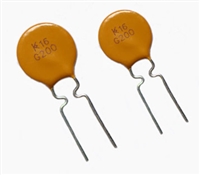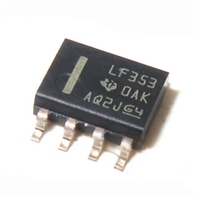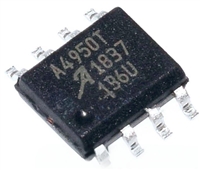LNK3202/3204-6
600
500
LinkSwitch-TN2 Functional Description
LinkSwitch-TN2 combines a high-voltage power MOSFET switch with
a power supply controller in one device. Unlike conventional PWM
(pulse width modulator) controllers, LinkSwitch-TN2 uses a simple
ON/OFF control to regulate the output voltage. The LinkSwitch-TN2
controller consists of an oscillator, feedback (sense and logic) circuit,
5.0 V regulator, BYPASS pin undervoltage circuit, over-temperature
protection, line and output overvoltage protection, frequency jittering,
current limit circuit, leading edge blanking and a 725 V power
MOSFET. The LinkSwitch-TN2 incorporates additional circuitry for
auto-restart.
VDRAIN
400
300
200
100
Oscillator
0
The typical oscillator frequency is internally set to an average of fOSC
(66 kHz). Two signals are generated from the oscillator: the maximum
duty cycle signal (DC(MAX)) and the clock signal that indicates the
beginning of each cycle.
68 kHz
64 kHz
0
20
The LinkSwitch-TN2 oscillator incorporates circuitry that introduces a
small amount of frequency jitter, typically 4 kHz peak-to-peak, to
minimize EMI emission. The modulation rate of the frequency jitter is
set to 1 kHz to optimize EMI reduction for both average and quasi-
peak emissions. The frequency jitter should be measured with the
oscilloscope triggered at the falling edge of the DRAIN waveform.
The waveform in Figure 5 illustrates the frequency jitter of the
LinkSwitch-TN2.
Time (µs)
Figure 5. Frequency Jitter.
BYPASS Pin Undervoltage
The BYPASS pin undervoltage circuitry disables the power MOSFET
when the BYPASS pin voltage drops below VBP–VBPH (approximately 4.5 V).
Once the BYPASS pin voltage drops below this threshold, it must rise
back to VBP to enable (turn-on) the power MOSFET.
Feedback Input Circuit
Over-Temperature Protection
The feedback input circuit at the FEEDBACK pin consists of a low
impedance source follower output set at VFB (2.0 V). When the
current delivered into this pin exceeds IFB (49 μA), a low logic level
(disable) is generated at the output of the feedback circuit. This
output is sampled at the beginning of each cycle on the rising edge
of the clock signal. If high, the power MOSFET is turned on for that
cycle (enabled), otherwise the power MOSFET remains off (disabled).
The sampling is done only at the beginning of each cycle. Subse-
quent changes in the FEEDBACK pin voltage or current during the
remainder of the cycle do not impact the MOSFET enable/disable
status. If a current greater than IFBSD is injected into the feedback pin
while the MOSFET is enabled for at least two consecutive cycles the
part will stop switching and enter auto-restart off-time. Normal
switching resumes after the auto-restart off-time expires. This
shutdown function allows implementing line overvoltage protection in
flyback converters (see Figure 6). The current into the FEEDBACK pin
should be limited to less than 1.2 mA.
The thermal shutdown circuitry senses the die temperature. The
threshold is set at TSD (142 °C typical) with a 75 °C (TSDH) hysteresis.
When the die temperature rises above TSD the power MOSFET is
disabled and remains disabled until the die temperature falls to
TSD–TSDH, at which point it is re-enabled.
Current Limit
The current limit circuit senses the current in the power MOSFET.
When this current exceeds the internal threshold (ILIMIT), the power
MOSFET is turned off for the remainder of that cycle. The leading
edge blanking circuit inhibits the current limit comparator for a short
time (tLEB) after the power MOSFET is turned on. This leading edge
blanking time has been set so that current spikes caused by capaci-
tance and rectifier reverse recovery time will not cause premature
termination of the switching pulse. Current limit can be selected using
the BYPASS pin capacitor (0.1 μF for normal current limit / 1 μF for
reduced current limit). LinkSwitch-TN2 selects between normal and
reduced current limit at power-up prior to switching.
5.0 V Regulator and 5.2 V Shunt Voltage Clamp
The 5.0 V regulator charges the bypass capacitor connected to the
BYPASS pin to VBP by drawing a current from the voltage on the
DRAIN, whenever the MOSFET is off. The BYPASS pin is the internal
supply voltage node for the LinkSwitch-TN2. When the MOSFET is
on, the LinkSwitch-TN2 runs off of the energy stored in the bypass
capacitor. Extremely low power consumption of the internal circuitry
allows the LinkSwitch-TN2 to operate continuously from the current
drawn from the DRAIN pin. A bypass capacitor value of 0.1 μF is
sufficient for both high frequency decoupling and energy storage.
Auto-Restart
In the event of a fault condition such as output overload, output
short, or an open-loop condition, LinkSwitch-TN2 enters into
auto-restart operation. An internal counter clocked by the oscillator
gets reset every time the FEEDBACK pin is pulled high. If the
FEEDBACK pin is not pulled high for tAR(ON) (50 ms), the power
MOSFET switching is disabled for a time equal to the auto-restart
off-time. The first time a fault is asserted the off-time is 150 ms
(tAR(OFF) First Off Period). If the fault condition persists, subsequent
off-times are 1500 ms long (tAR(OFF) Subsequent Periods). The
auto-restart alternately enables and disables the switching of the
power MOSFET until the fault condition is removed. The auto-restart
counter is gated by the switch oscillator.
In addition, there is a shunt regulator clamping the BYPASS pin at
VBP(SHUNT) (5.2 V) when current is provided to the BYPASS pin through
an external resistor. This facilitates powering of LinkSwitch-TN2
externally through a bias winding to decrease the no-load consump-
tion to about 10 mW (flyback). The device stops switching instantly
and enters auto-restart when a current ≥IBPSD is delivered into the
BYPASS pin. Adding an external Zener diode from the output voltage
to the BYPASS pin allows implementing an hysteretic OVP function in
a flyback converter (see Figure 6). The current into the BYPASS pin
should be limited to less than 16 mA.
3
Rev. F 01/17
www.power.com






 NTC热敏电阻与PTC热敏电阻的应用原理及应用范围
NTC热敏电阻与PTC热敏电阻的应用原理及应用范围

 GTO与普通晶闸管相比为什么可以自关断?为什么普通晶闸管不能呢?从GTO原理、应用范围带你了解原因及推荐型号
GTO与普通晶闸管相比为什么可以自关断?为什么普通晶闸管不能呢?从GTO原理、应用范围带你了解原因及推荐型号

 LF353数据手册解读:特性、应用、封装、引脚说明、电气参数及替换型号推荐
LF353数据手册解读:特性、应用、封装、引脚说明、电气参数及替换型号推荐

 A4950资料手册解读:特性、应用、封装、引脚功能、电气参数及代换型号
A4950资料手册解读:特性、应用、封装、引脚功能、电气参数及代换型号
